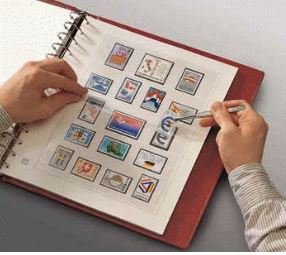Displaying your stamp collection is one of the most rewarding aspects of being a collector. It allows you to share your passion with others and take pride in the treasures you’ve carefully acquired. However, the way you display your stamps can greatly impact their presentation, value, and longevity. In this article, we’ll explore how to display stamp collections in a way that maximizes their visual impact while avoiding common display pitfalls that could damage your valuable collection.

1. Choose the Right Display Method
One of the first steps in learning how to display stamp collections is choosing the right display method. There are several ways to present your stamps, but the method you choose should ensure your collection is not only visually appealing but also well-protected. Popular display options include:
- Stamp Albums: A classic and safe method for displaying stamp collections. These albums provide organized pages with pockets or mounts, allowing for easy viewing and protection.
- Frames: For a more decorative display, frames can be an excellent choice. Choose frames that can accommodate the size of your stamps and have protective glass to shield them from dust and sunlight.
- Display Boxes: These are a great option for collectors who want to show off multiple stamps at once in a compact, organized way. Display boxes often come with a transparent lid for easy viewing.
Knowing how to display stamp collections effectively involves selecting a display method that protects your stamps while also making them easy to admire.
2. Consider Proper Lighting
Lighting is one of the most important factors when learning how to display stamp collections. Stamps are made of delicate paper, and exposure to harsh lighting or sunlight can cause fading and deterioration over time. To preserve the quality and color of your stamps, consider the following:
- Avoid Direct Sunlight: Direct exposure to sunlight can cause irreversible damage, especially to stamps with vibrant colors. Place your collection in a spot where it will be protected from prolonged sunlight.
- Use UV-Protected Lighting: UV rays can cause paper to yellow and degrade over time. Use UV-protected lights or LED bulbs to illuminate your collection without harming it.
- Soft, Indirect Lighting: Opt for soft, diffused lighting that won’t cast harsh shadows but will still highlight your stamps’ details.
Proper lighting can elevate your collection, but understanding how to display stamp collections while avoiding excessive light exposure is key to protecting your stamps’ longevity.
3. Organize Your Collection Logically
An essential part of how to display stamp collections is organizing them in a way that’s easy to follow and visually appealing. Whether you choose to display by country, era, theme, or rarity, having a clear organizational structure will enhance the presentation of your collection.
- Thematic Display: Arrange stamps according to specific themes such as historical events, wildlife, or royal figures. This approach helps tell a story and makes the collection more engaging.
- Chronological Order: Displaying stamps in the order of their issuance can provide a historical perspective, showcasing the evolution of design and printing techniques.
- Rarity: If your collection includes rare stamps, consider dedicating a special section to showcase them. This not only highlights their importance but also adds an element of exclusivity to your display.
Knowing how to display stamp collections in an organized manner ensures that viewers can appreciate the uniqueness of each stamp while maintaining an aesthetically pleasing arrangement.

4. Use Proper Mounting and Storage Materials
When learning how to display stamp collections, it’s crucial to invest in the right mounting and storage materials. Poor-quality materials can cause damage over time, potentially reducing the value of your collection. Here’s how to ensure your stamps stay safe:
- Acid-Free Mounts and Albums: Use acid-free mounts or hinges to attach your stamps to pages. Acidic materials can cause stamps to discolor and deteriorate.
- Glassine Envelopes: These envelopes are made from a smooth, transparent paper that offers protection while allowing you to view your stamps. They help keep stamps free from dust and handling damage.
- Mounts and Hinges: If you’re framing your stamps, use safe mounts or hinging techniques to avoid direct contact with the frame glass, as this could damage the stamps over time.
Choosing the right materials is essential when learning how to display stamp collections without compromising their condition.
5. Avoid Overcrowding
When displaying your stamp collection, it can be tempting to fit as many stamps as possible into a limited space. However, overcrowding can diminish the visual impact of your collection and increase the risk of damage. Here’s how to avoid this pitfall:
- Leave Space for Each Stamp to Breathe: Each stamp should have enough space to be viewed clearly without being cramped against others. This will not only make your collection more visually appealing but will also help prevent the stamps from being damaged by rubbing or pressure.
- Highlight Key Pieces: Rather than trying to showcase everything at once, focus on the most valuable or unique pieces of your collection. This allows you to draw attention to special stamps while maintaining an organized and aesthetically pleasing display.
When learning how to display stamp collections, remember that less is often more. Proper spacing helps each stamp shine and avoids the risk of overcrowding, which can detract from the overall look.
6. Keep Humidity and Temperature in Check
Stamps are sensitive to environmental changes, particularly humidity and temperature. Displaying your stamps in a controlled environment is essential for maintaining their condition. High humidity can cause the paper to warp, while extreme temperatures can cause the stamps to crack or become brittle.
- Avoid Damp Areas: Never display your collection in places like basements or bathrooms where humidity levels can fluctuate.
- Maintain Stable Temperature: Aim for a room temperature between 65°F and 75°F (18°C to 24°C). Avoid placing your collection near heat sources, such as radiators or air conditioners, as this can cause fluctuations in temperature.
By controlling the environment where you display your stamp collection, you can avoid unnecessary damage and preserve the value of your collection.
7. Avoid Handling Stamps Too Much
One of the most common mistakes in how to display stamp collections is excessive handling. Every time you touch a stamp, you risk transferring oils and dirt from your fingers, which can degrade its condition over time. To avoid this, follow these tips:
- Use Tweezers or Tongs: If you need to move or adjust a stamp, use a pair of stamp tongs or tweezers. This prevents direct contact with your stamps and minimizes the risk of damage.
- Keep Stamps Behind Glass or in Protective Sleeves: When displaying stamps, ensure they are safely behind protective glass or stored in acid-free sleeves. This reduces the need for direct handling.
By minimizing handling, you protect your stamps from unnecessary wear and tear, ensuring they remain in top condition for years to come.

To deepen your understanding of how to invest in rare stamps, it’s crucial to explore more detailed insights and strategies. Whether you’re just starting out or looking to refine your investment approach, learning about the different types of rare stamps, market trends, and key factors like condition and rarity will give you the knowledge needed to make informed decisions. For a more in-depth guide on how to invest in rare stamps, be sure to check out our comprehensive article on this topic here.
Conclusion
Learning how to display stamp collections is a crucial skill for any collector, whether you’re showcasing your stamps in a personal display or preparing them for an exhibition. By choosing the right display method, controlling the lighting, organizing your collection, and using proper materials, you can maximize the impact of your display while avoiding common pitfalls that could harm your valuable stamps. With the right care and attention, your collection will continue to be a source of pride and enjoyment for years to come.



